| |
HIGHLIGHTS & CELEBRATIONS
FROM THE 6TH ANNUAL RECOMB/ISCB CONFERENCE ON REGULATORY & SYSTEMS
GENOMICS, WITH DREAM CHALLENGES
By Christopher M. Williams
In November 2013, close to 300 researchers gathered in Toronto,
Canada for the 6th Annual RECOMB/ISCB Conference on Regulatory and
Systems Genomics, with DREAM Challenges. In its second year as an
official conference of the International Society for Computational
Biology, the event featured 16 keynote lectures, 55 short talks, and
nearly 100 poster presentations organized into two tracks that
highlighted recent efforts to understand the organization, function,
and regulation of complex molecular biological systems. In addition,
the conference held the annual meeting of the Dialogue for Reverse
Engineering Assessment and Methods (DREAM), which included short
talks by the best performers in the DREAM8 Challenges.
 |
| Attendees from the Sixth Annual
RECOMB/ISCB Conference on Regulatory and Systems Genomics,
with DREAM Challenges held in Toronto, Canada |
DREAM
In advance of this conference, DREAM
posed three challenges to the systems and computational biology
community that were designed to assess the relative usefulness of
competing approaches for modeling complex biological systems, and to
generate insights that could contribute to the solution of several
practical biological problems. Over the course of the challenges,
more than 600 teams registered and 369 submitted entries, doubling
the participation of last year. The best performers in each of the
challenges were announced at the conference, and representatives of
the teams gave short talks explaining their approaches. These DREAM
challenges were organized in close collaboration with Sage
Bionetworks, and are the first round of challenges since DREAM and
Sage Bionetworks announced their partnership in February 2013.
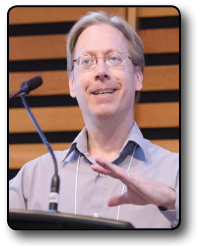 |
Fred Wright, Speaker,
North Carolina State
University |
The HPN-DREAM Breast Cancer Network Inference Challenge, held in
partnership with the Heritage Provider Network (HPN) and using
previously unpublished data from a collection of breast cancer cell
lines, invited participants to predict regulatory networks
(subchallenge 1), generate dynamic models of phosphoprotein
interactions (subchallenge 2), and devise novel approaches to
visualizing these high-dimensional datasets as they change over time
(subchallenge 3). The best performing teams in subchallenge 1 were
Team DC_TDC (Artem Sokolov, Daniel Carlin, Evan Paull, Kiley Graim,
Adrian Bivol, Chris Wong, Josh Stuart) from the Uniersity of
California at Santa Cruz, and Team NMSUSongLab (Yang Zhang, Haizhou
Wang, and Mingzhou Song), from New Mexico State University. Best
performers in subchallenge 2 were Team GuanLab (Fan Zhu and Yuanfang
Guan) from University of Michigan, Team StochasticChaos (Bahman
Afsari, Ludmila Danilova, Alexander Favorov, Wai-shing Lee, Dane
Taylor, and Elana Fertig) from Johns Hopkins University, and Team
CGR (Ying Hu, Chunhua Yan, Chih-Hao Hsu, George Komatsoulis, Yu Liu,
and Daoud Meerzaman) from the National Cancer Institute. The best
performer of subchallenge 3 was Team ABCD (Wendy Hu, Alex Bisberg,
Byron Long, Dave Noren, Amina Ann Qutub) from Rice University. All
teams but one presented at the conference. For more information on
this challenge, go to
www.synapse.org/#!Synapse:syn1720047.
The NIEHS-NCATS-UNC DREAM Toxicogenetics Challenge, developed in
collaboration with the National Institute of Environmental Health
Sciences (NIEHS), the National Center for Advancing Translational
Sciences (NCATS), and the University of North Carolina at Chapel
Hill, asked researchers to participate in two subchallenges: 1) use
genetics (SNPs), RNA-seq, and toxicity data to predict how
individuals will respond to chemical toxicants, and 2) use intrinsic
chemical properties to predict the toxicity in a population (median
and interquartile distances) of new chemicals for which toxicologic
studies have not been done. Team Yang_Lab (Tao Wang, Hao Tang,
Xiaowei Zhan, Jichen Yang, Rui Zhong, Guanghua Xiao, and Yang Xie)
from the University of Texas Southwestern) was the best performer in
both subchallenges. Interestingly, this team was also the best
performer in one of the two NCI-DREAM challenges of DREAM7 in 2012.
They, as well as Team Cassis (Elsa Bernard, Erwan Scornet, Yunlong
Jiao, Veronique Stoven, Thomas Walter, and Jean-Philippe Vert) from
the Institut Curie, who were t
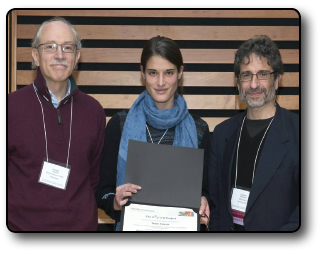 |
Left to right: Woychik Richard,
National Institutes of Health;
Elsa Bernard (Team
Cassis,
Mines ParisTech, France);
Gustavo
Stolovitzky,
Conference Chair. |
he second best performers in
subchallenge 1, presented their work at the DREAM track of the
conference. For more information on this challenge, go to
www.synapse.org/#!Synapse:syn1761567.
The third
challenge, which developed from a presentation by Markus Covert
(Stanford University) at the 2012 RECOMB-DREAM conference, called on
participants to explore a computational whole-cell model of M.
genitalium (WholeCellViz) and identify a set of parameters that had
been altered in comparison with those in a model wild-type strain.
The challenge was designed to address what Covert described as one
of the biggest problems he and his colleagues have faced; namely,
the problem of parameter estimation in light of the vastness and
inherent stochasticity in the model. The best performers in this
challenge were Team Crux (Clemens Kreutz, Andreas Raue, Bernhard
Steiert and Jens Timmer) from the University of Freiburg, who also
preformed best in a similar challenge in DREAM7, and Team Whole-Sale
Modelers (Alex H Williams and Jeremy Zucker) from Brandeis
University). Both teams presented their work during the conference.
For more information about this challenge, go to
www.synapse.org/#!Synapse:syn1876068
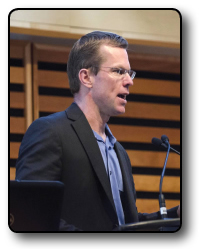 |
Trey Ideker, Keynote
Speaker
(University of
California, San Diego) |
DREAM also
featured two keynote talks. In the first, Trey Ideker (University of
California, San Diego) introduced a new web-based database called
the Network Extracted Ontology (NeXO), which integrates data from
large collections of gene and protein interactions to build a
hierarchy of cellular components and processes. This approach
inverts the traditional use of ontologies in genomics, enabling a
shift away from using ontologies (such as Gene Ontology) as prior
knowledge for evaluating new data sets and toward using new data
sets to construct and evaluate ontologies. Tim Hughes (University of
Toronto) described some of his lab�s work with that of Quaid Morris
to develop a database called the Catalog of Inferred Sequence
Binding Preferences of RNA Binding Proteins. By identifying
similarities between binding motifs across species, their approach
makes it possible to predict motifs for 10,000 proteins. In
particular, there seems to be a high degree of conservation in the
3� UTR, Hughes mentioned, suggesting that RBPs may play a major role
in regulating the stability of transcripts.
Systems
Biology
Beginning on the conference's second day,
talks in the systems biology track covered topics related to the
dissection of cell regulatory networks, studies of genetics and
genomics, the characterization of signaling pathways and metabolic
networks, the systems biology of development and disease, and recent
efforts to clarify drug mechanisms of action. Keynote addresses in
this track provided a compelling snapshot of some key challenges
that the discipline currently seeks to address.
Peter
Jackson (Stanford University) opened the track by describing how his
lab uses network building tools to understand drivers of genetic
disease. He focused on studies of the molecular mechanisms that are
important in cilia, and showed how intersections between these
networks and those involved in obesity and diabetes are providing
insights into the underlying genetic and signaling networks that
drive disease. Peter Sorger (Harvard Medical School) drew attention
to the problems posed by the high variability of drug response in
individual patients. He suggested that in the future, drug
development will have to consider not just complexity in the
regulatory networks that drugs target, but also the complexity of
the perturbations that drugs cause. Bernhard Palsson (University of
California, San Diego) discussed some recent applications of
constraint-based modeling -- an approach that considers biological
limits on possible network solutions -- for the analysis of metabolic
networks. Palsson described some interesting findings that this
approach has produced related to synthetic lethal drug targets, the
characterization of enzymes within metabolic networks, and studies
connecting genotype to phenotype.
Opening the second day of
the systems biology track, Olivier Pourquie (University of
Strasburg) showed how combining genomic approaches with
developmental biology manipulations in Drosophila can provide
insights into cross-talk between physiological systems. Levi
Garraway (Dana Farber Cancer Institute) described work in his lab to
identify a phenomenon called chromoplexy, in which multiple DNA
translocations and deletions arise in a highly interdependent
manner. He also discussed the difficulty of understanding drug
resistance in cancer, suggesting the "disturbing possibility" that
there may be a range of mechanisms through which resistance occurs.
If this is the case, finding downstream targets where resistance
pathways "coalesce" may offer a more effective strategy than
targeting individual pathways, he argued. Brenda Andrews (University
of Toronto) described a technology her lab has developed called the
synthetic genetic array, which systematically creates double mutants
in order to produce a comprehensive map of gene-gene interactions.
She described some findings in her lab that have come from using
this approach, as well as recent efforts to integrate
high-throughput microscopy into this technology to observe protein
abundance and localization within the cell.
The systems
biology track also featured a special lecture in memory of Tony
Pawson, who had agreed to participate in the conference as a keynote
speaker before his untimely death in August 2013. Jeff Wrana (Mount
Sinai Hospital, Canada), a former collaborator with Pawson, gave a
moving survey of the importance of Pawson's insights into the nature
of protein-protein interactions in signaling pathways, and of how
his revolutionary discoveries changed the existing paradigm and laid
the groundwork for later research on cell signaling.
Regulatory Genomics
Held on the final two days of
the conference, the regulatory genomics track explored advances in
scientists' efforts to understand genome regulation at multiple
levels. Speakers presented talks about evolution at the molecular
level, cell differentiation, enhancers of gene expression, genomic
variation, and transcription factor binding, and about several new
technologies for extracting biological insights from omics data.
Collectively, the talks highlighted recent advances in the effort to
explain the highly complex and dynamic molecular systems at work in
cells.
Aviv Regev (Broad Institute) discussed a protocol her
lab has developed for using single-cell RNA sequencing to study
variability in dendritic cells. Experiments identified a small
subset of "early responder" dendritic cells that initiate interferon
signaling, activating an antiviral response and dampening the
inflammatory response across a cell population. Ziv Bar-Joseph
(Carnegie Mellon University) also highlighted the dynamic nature of
regulatory networks, and described methods his lab has developed for
combining genomic sequence, RNA-seq, and protein-protein interaction
data with time-dependent data related to gene expression and
epigenomic activity, in order to track changes in networks over
time. Using an algorithm called mirDREM, his lab has reconstructed
dynamic microRNA-regulated interaction networks to study lung
development in mice, and ultimately hopes to use the approach to
correlate underlying regulatory networks to disease phenotypes in
patients.
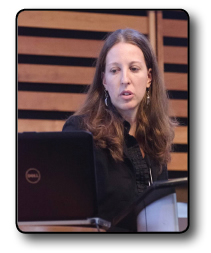 |
Galit Lahav, Keynote
Speaker,
Harvard Medical
School, Cambridge,
United States |
Galit Lahav (Harvard Medical School) presented recent work
investigating the relationship between double-stranded DNA breaks
and pulsing in expression of the transcription factor p53, a tumor
suppressor that is mutated in 50% of all human cancers. In studies
using gamma radiation and fluorescent reporters for quantifying DNA
damage, her lab found that averaging the activation of p53 across a
population of cells loses important features of the relationship
between DNA breaks and p53 pulsation that can be seen more clearly
in studies focusing on single cells. Describing studies of
Drosophila development, Jason Lieb (Princeton University) explained
that differences in the accessibility of enhancers of master
regulator transcription factors on chromatin may account for the
fact that different body parts can arise from the same genomic
information.
On the final day of the conference, Emmanouil
Dermitzakis (University of Geneva) explained how combining RNA-seq
with whole genome sequence data offers new opportunities for
understanding the regulation of gene expression by noncoding DNA.
Surveying research his lab has conducted as a part of the SysCol
consortium, he suggested that there may be germline DNA variants
that do not themselves cause colorectal cancer, but become drivers
of cancer via cis-regulatory effects once a cell becomes cancerous.
Jussi Taipale (University of Helsinki) described his lab's efforts
to undertake genome-wide analyses of binding affinities between DNA
and transcription factors, including studies comparing human and
Drosophila. Recently, they have begun using software called the
Enhancer Element Locator (EEL), which aligns the order of
transcription factor binding motifs. The researchers have identified
600 high-quality binding profiles for human, mouse, and fly genomes,
and have gained valuable insights into the binding profiles of
heterodimeric transcription factors. Brenton Graveley (University of
Connecticut) gave an overview of his lab's efforts to characterize
the dynamics and variability of alternative splicing events in
Drosophila across time and in different tissues. In recent work
focusing on the Drosophila Dscam gene, he has used a method called
triple read sequencing to identify when and where individual
isoforms of specific exons are expressed. His outcomes have
uncovered the concept that alternative splicing is probabilistic,
whereby the repertoire of RNA binding proteins expressed in
subclasses of neurons determines the probability for each exon being
expressed in that subclass of neurons.
For more information
about this conference, go to
www.iscb.org/recomb-regsysgen2013, where you can see a selection
of talks and download the program guide, which includes abstracts
for all of the talks and posters presented at the conference.
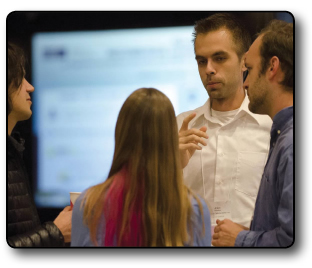 RECOMB/ISCB Regulatory and System Genomics Conference
with DREAM 2014 RECOMB/ISCB Regulatory and System Genomics Conference
with DREAM 2014
The planning for the 2014 conference
is well underway. Mark your calendars now and plan to join us in San
Diego, California, USA, November 10-14. We are now accepting
submissions of papers, abstracts, and responses to the DREAM
Challenges. To learn more visit
www.iscb.org/recomb-regsysgen2014-submissions/recomb-regsysgen2014-call.
top |

